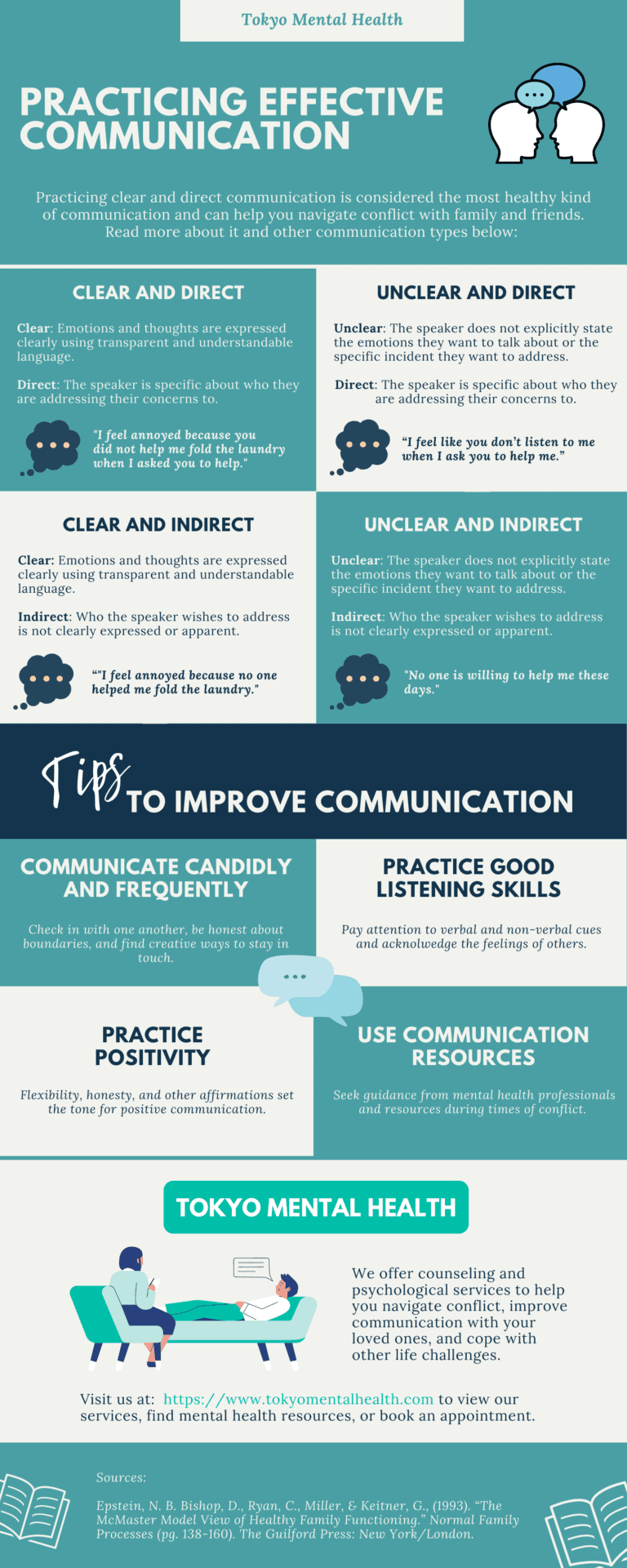- 2021/01/17
- Self Help & Tips
In unprecedented times like these, it is more important than ever to lean on friends and family. Even when it is difficult to meet in person, finding the time and means to connect with others through effective communication can offer precious support and guidance in periods of uncertainty. However, it can be difficult to know where to start, especially when discussing vulnerable or personal topics.

Are there different types of communication?
Communication can come in many forms. Norman B. Epstein, an international leader in couple and family therapy, outlines four communication styles:
- Clear and direct communication
- Clear and indirect communication
- Unclear and direct communication
- Unclear and indirect communication
Clear and direct communication
Clear and direct communication is considered the most healthy form of communication. It is achieved by using transparent and understandable language to express feelings, thoughts, and emotions (Epstein et al., 1993). While the communication can be done both verbally (with words or language) and non-verbally (through gestures or other means), Epstein suggests that verbal communication is typically more effective as a form of communication.
What can I do to communicate clearly and directly?
Communication that is considered clear and direct states the intended recipient of the speaker, the emotions that the original speaker is having, as well as the reason for feeling a certain way. An example of this may be, “I am feeling upset because you did not help me carry the groceries into the house when I asked you multiple times to help.”
Clear and indirect communication
While the intent of communication is clear in this form, the recipient of the speaker’s emotions is not stated or apparent (Epstein et al., 1993).
Clear and indirect communication is effective at conveying the speaker’s message, but it often leaves the addressed person confused as to who the feelings are being addressed to. This may result in the recipient mistakenly assuming that the message was not intended for them. Following the previous example, a clear and indirect form of communication is; “I feel upset because no one helped me carry the groceries into the house.”
Unclear and direct communication
This type of communication clearly refers to the intended recipient, but does not explicitly state the content or emotions that the speaker is trying to convey. This makes communication less effective because the message becomes unclear (Epstein et al., 1993).
Furthermore, the addressed person may draw incorrect conclusions about what the communicator was trying to say, which can cause further misunderstandings. An example of unclear and direct communication is, “I feel like you don’t listen to me when I ask you to help me.”
Unclear and indirect communication
Unclear and indirect communication is an unhealthy method of communication. In this case, both the message and the intended recipient are unclear (Epstein et al., 1993). This can often manifest itself as “passive-aggressive” communication. An example of this is, “No one is willing to help me these days.”
Four tips to ensure effective communication
There are many ways to build effective and healthy communication strategies to strengthen your relationships:
Frequent and candid communication
Considering that the methods and circumstances of communication have changed, it has become more important to regularly communicate with others. This is for a myriad of reasons, including maintenance of positive boundaries and ensuring the emotional wellbeing of self and loved ones.
It can be a challenge to establish times to properly communicate. However, communication can be done in many ways — over the phone, in video calls, through text or instant messaging, or in person if circumstances allow. Communication does not necessarily require an appointment.
Good listening skills
An equally essential aspect of communication is being an active listener. Active listening involves trying one’s best to understand the point of view of the communicator — putting yourself in their shoes. This includes paying attention to both verbal and nonverbal cues. Furthermore, acknowledging the other person’s feelings and letting them know can establish a positive and healthy atmosphere for them to speak their mind.
Being positive
In most cases, effective communication is achieved through positive communication patterns as opposed to negative ones. For example; flexibility, honesty, and other affirmations set the tone for positive communication. This is opposed to negative communication patterns, such as putting down the other person or becoming defensive, which may lead to further confrontation and an unwillingness to be a proper listener.
Communication Resources
While effective communication may seem like a straightforward concept, it can at times be challenging to properly execute. We at Tokyo Mental Health understand the importance for communication, as well as the potential difficulties that may arise. If you are ever experiencing difficulties communicating with friends, family, and loved ones, experienced counselors and psychologists at Tokyo Mental Health would love to help. We are committed to providing excellent mental health care services, and are available for both in person and online appointments. For bookings and enquiries, contact us at [email protected] or visit our website to simply fill in the enquiry form.
Sources
Epstein, N. B. Bishop, D., Ryan, C., Miller, & Keitner, G., (1993). “The McMaster Model View of Healthy Family Functioning.” Normal Family Processes (pg. 138-160). The Guilford Press: New York/London.